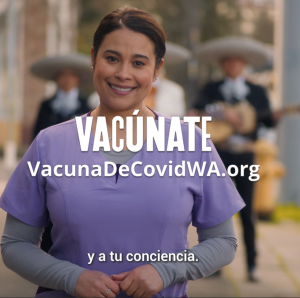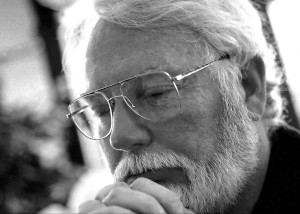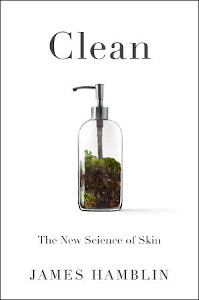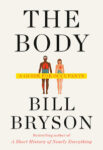Posted by Elena del Valle on June 6, 2022

Talia Henkle, Ph.D., cancer content creator, Sparrow
Photo: Talia Henkle
A podcast interview with Talia Henkle, Ph.D., cancer content creator, Sparrow, is available in the Podcast Section of Hispanic Marketing and Public Relations, HispanicMPR.com. During the podcast, she discusses cancer with Elena del Valle, host of the HispanicMPR.com podcast.
Talia received her doctorate degree in immunology at Johns Hopkins University where she studied oncology, virology and cancer immunotherapies. Talia is a content creator for Sparrow highlighting cancer research by creating digestible articles designed for non-experts to easily understand.
To listen to the interview, scroll down and click on the play button below. You can listen by looking for “Podcast” then select “HMPR Talia Henkle, Ph.D.” and download the MP3 file to your audio player. You can also find it on the RSS feed. To download it, click on the arrow of the recording you wish to copy and save it to disk. The podcast will remain listed in the June 2022 section of the podcast archive.
Posted by Elena del Valle on April 6, 2022

Washington Hispanic market campaign videos link to VacunaDeCovidWA.org
Photo: Tony Teran
Video: Washington State Department of Health
Hoping to reach Hispanics between 18 and 35 years of age hesitant about pandemic vaccines in Washington state with a pro Covid-19 vaccinations message the Washington State Department of Health hired C+C. The Seattle-based marketing agency produced audio and two video spots in Seattle. Production costs for Vacúnate Mijo/a were $168,000 and $205,000 for Mentira Mariachi. The ads were produced for broadcast distribution, YouTube, TikTok and radio. Scroll down to watch videos in English and Spanish (with subtitles).
When C+C conducted the initial research that led to the campaigns’ development, the team found that while most Hispanic people in Washington state were “very willing or somewhat willing” to take a Covid-19 vaccine more English-speaking survey respondents expressed vaccine hesitancy than Spanish speakers. Overall, 62 percent of survey takers said they were very willing or somewhat willing to receive a Covid-19 vaccine; 67 percent of Spanish speakers and 56 percent of English speakers said they were very or somewhat willing to get vaccinated; 2 percent of Spanish speakers who responded to the survey compared to 18 percent of English speakers who responded to it said they would not take the vaccine; 27 percent of Spanish speakers versus 23 percent of English speakers who answered questions said they were unsure; more English speakers than Spanish speakers said they thought Covid-19 vaccines may be unnecessary and ineffective; and more English speakers than Spanish speakers said they had other ways to protect themselves against the virus.
According to a C+C spokesperson the overall goal of the campaigns was “to increase vaccination rates among the Hispanic community in Washington by tackling key research findings. Misinformation on vaccine safety and efficacy was indicated as one of the main drivers of vaccine hesitancy among this community. While protecting themselves, their loved ones, and their community ranked as the main motivation for getting vaccinated.”
The agency addressed concerns about trust in the vaccines with emotional pleas to family ties, Spanish language and Mariachi music. Tony Teran, campaign writer and creative director, C+C, replied by email via an intermediary, “At the center of the Vacúnate Mijo/a campaign is the relationship between a grandchild and a grandmother or abuela, a much loved and nostalgic figure among many Hispanic/Latinx families, often seen as a trusted voice of reason. We follow their bond through different life stages that showcase the core of our message: protecting each other. The Spanish language is also a powerful connecting thread in these ads, as we hear the word mijo/a express different emotions at different times, a word so simple, yet incredibly purposeful. Abuela is saying ‘I care about you’ with every mijo and ultimately encouraging her grandchild to receive the vaccine.
The idea behind the Mentira Mariachi campaign is that we all listen to the voice of our conscience when making decisions. So, what if that voice came accompanied by trumpets and guitarrón, as in traditional Mariachi music, to remind audiences to listen to science and their good judgement, and not to misinformation? The :30 video spot shows a young guy at home. Every time he is exposed to fake news about the COVID-19 vaccines, he’s surprised by a Mariachi band popping out of nowhere to humorously remind him, with a catchy jingle, that those are mentiras (lies). At the end of the spot, we see him coming out of a vaccination site after getting his shot as Mariachi band members give him a nod of approval and a health care worker delivers the campaign’s tagline: ‘Escucha a la ciencia y a tu conciencia.’ (Listen to science and to your conscience.)”
The Vacúnate Mijo/ ad goal was to encourage community members to get vaccinated by emphasizing the importance of protecting their loved ones during the pandemic; while the Mentira Mariachi ad was meant to dissipate vaccine misinformation by encouraging the audience to “trust science.”
According to information provided by C+C the Hispanic population in the state represents 13 percent of the total population, yet in mid-July 2021, had 27 percent of the coronavirus cases, 19 percent of total hospitalizations, and 8.4 percent of total deaths in Washington; about 60 percent of the state’s Hispanic population remained unvaccinated, according to the Washington Department of Health.

Tony Teran, creative director, C+C
“Creative concepting for both of the campaigns began in August 2021,” Teran replied when asked how many months the campaign project required. “Vacúnate Mijo/a launched in November 2021 while Mentira Mariachi launched in February 2022.
The C+C team used three different types of research when developing the strategy and concept for this Hispanic/Latinx-focused campaign: 1:1 Interviews, since 2020, the team has been conducting monthly 1:1 in-depth interviews with Hispanic/Latinx community members to learn about their overall attitudes, barriers and motivators for getting a COVID-19 vaccine.
Focus Groups, C+C conducted four focus groups with Hispanic/Latinx community members to test the campaign’s creative approach and gain insights into what type of creative would resonate most with the community. A total of 20 community members participated.
Secondary Research, The Washington State Department of Health (DOH) and C+C worked hand-in-hand with partners like the University of Washington’s Latino Center for Health to analyze insights about vaccine hesitancy among the state’s Hispanic/Latinx population that helped shape the campaign, including a report released by the Center in April 2021. The team also referenced findings of COVID-19 surveys conducted regularly by the Bill & Melinda Gates Foundation/Civis Analytics.”
When asked how the agency measured results Teran replied, “We have been correlating the success of the campaigns with the increase in vaccination rates among Hispanic/Latinx adults in Washington. Approximately 63 percent of the Hispanic/Latinx community 18+ in Washington have initiated vaccination as of 3/25. This is up from 49.9 percent in November 2021 before the campaigns launched. This amounts to an increase of 13.1 percent. The overall vaccination gap has also closed by 7.4 percent among the Hispanic/Latinx community. The gap closed on Hispanic/Latinx community vaccination rates from being 29.5 percent behind the overall Washington state rates in November 2021 to only 22.1 percent behind in March 2022.”
The campaigns were developed and produced by a team that included members of Washington state’s Hispanic community, including Terán, the creative of Venezuelan roots behind the original concepts. He wrote the video and audio scripts, and oversaw the campaigns’ production process; featured Hispanic cast member for both campaigns; and the production team selected Spanish speaking talent seeking a cultural fit, and with good acting skills and on-camera presence, according to information provided by C+C.
The Vacúnate Mijo/a production included creative input from Mauricio Valadrian, of Valadrian Creative & Consulting; the Mentira Mariachi video production was co-directed by Marvin Lemus, director of Netflix’s Gentefied, and also a Hispanic creative; the Mentira Mariachi video and audio ads feature an original song written for that campaign by a Hispanic musician and performed on-screen by Tacoma-based Mariachi Ayutla, a mariachi band, according to information provided by C+C.
Mentira Mariachi ad in Spanish
Vacúnate Mijo ad in English
Posted by Elena del Valle on June 7, 2021

Jon Lieff, M.D., author, The Secret Language of Cells
Photo: Rocco Coviello
A podcast interview with Jon Lieff, M.D., author, The Secret Language of Cells, is available in the Podcast Section of Hispanic Marketing and Public Relations, HispanicMPR.com. He discusses why cell communication is important for our health with Elena del Valle, host of the HispanicMPR.com podcast.
Jon is a neuropsychiatrist and lecturer, active on social media. After completing his studies at Harvard Medical School, he pioneered integrated treatment programs for the elderly, medically ill, and brain-injured patients. For the past ten years, in his blog Searching for the Mind, he has discussed the latest scientific findings in neuroscience, animal behavior, cellular biology, immunology, and microbiology as they relate to the question of where mind can be found in nature. His book, The Secret Language of Cells: What Biological Conversations Tell Us About the Brain-Body Connection, the Future of Medicine, and Life Itself strives to explain the science of how different cells, bacteria and brain cells, blood cells and viruses speak the same language.
To listen to the interview, scroll down and click on the play button below. You can listen by looking for “Podcast” then select “HMPR Jon Lieff, M.D., author” and download the MP3 file to your audio player. You can also find it on the RSS feed. To download it, click on the arrow of the recording you wish to copy and save it to disk. The podcast will remain listed in the June 2021 section of the podcast archive.
Posted by Elena del Valle on March 22, 2021

Eric Goulder, M.D., founder, Heart Attack Stroke Prevention Center of Central Ohio
Photo: Heart Attack Stroke Prevention Center of Central Ohio
A podcast interview with Eric Goulder, M.D., founder, Heart Attack Stroke Prevention Center of Central Ohio (HASPC) is available in the Podcast Section of Hispanic Marketing and Public Relations, HispanicMPR.com. During the podcast, he discusses the link he believes exists between oral and cardiac health with Elena del Valle, host of the HispanicMPR.com podcast.
Eric Goulder worked for twenty years at Riverside Methodist Hospital in Columbus, Ohio. He then worked for ten years as a cardiologist, affiliated with Marietta Memorial Hospital, until he opened the HASPC of Central Ohio. According to his bio he is an accredited provider of the Bale Doneen (BD) Method said to be used by “hundreds of practitioners worldwide” and meant to incorporate “the most current, research-based information along with painless non-invasive tests, simple blood tests and genetic information to help predict and prevent heart attacks and ischemic strokes.”
To listen to the interview, scroll down and click on the play button below. You can listen by looking for “Podcast” then select “HMPR Eric Goulder, M.D.” and download the MP3 file to your audio player. You can also find it on the RSS feed. To download it, click on the arrow of the recording you wish to copy and save it to disk. The podcast will remain listed in the March 2021 section of the podcast archive.
Posted by Elena del Valle on March 1, 2021

John Incledon, president, Hisamitsu America
Photo: Andrew Foord
A podcast interview with John Incledon, president, Hisamitsu America, is available in the Podcast Section of Hispanic Marketing and Public Relations, HispanicMPR.com. During the podcast, he discusses his company’s success with topical pain relief products in the Hispanic market with Elena del Valle, host of the HispanicMPR.com podcast.
John is also chief executive officer of Hisamitsu America. According to his biography he has a broad background in marketing, new product development, management, team building, global commercialization, sales, in-licensing, and acquisitions and divestitures.
To listen to the interview, scroll down and click on the play button below. You can also listen by looking for “Podcast” then select “HMPR John Incledon” and or download the MP3 file to your iPod or MP3 player to listen on the go, in your car or at home. You can also find it on the RSS feed. To download it, click on the arrow of the recording you wish to copy and save it to disk. The podcast will remain listed in the February 2021 section of the podcast archive.
Posted by Elena del Valle on October 6, 2020
By Linville M. Meadows, M.D., author, A Spiritual Pathway To Recovery

Linville M. Meadows, M.D., author, A Spiritual Pathway To Recovery
Photo: Linville M. Meadows
Addiction is a truly universal illness. It spares no demographic, cutting across all social boundaries: income, gender, ethnic background, age, and occupation. It can afflict an upper level executive, a physician or lawyer, a ditch-digger or a sales clerk. Substance abuse is found in every part of the world, with a prevalence of about ten percent. If you’re sitting at a meeting of sixty people, it’s likely that six are afflicted by addiction in one form or another.
When sober, addicts are wonderful people: kind, generous, and thoughtful. They are intelligent, hard-working, and creative. But when drunk or stoned, they become unreliable, dishonest, even mean. You will remember Dr. Jekyll, who injected himself with cocaine, unleashing the perfectly terrible and homicidal Mr. Hyde. Click to read the entire Guest Article: Understanding Addiction in the Workplace
Posted by Elena del Valle on September 29, 2020

Jenni Lehtimäki, Ph.D., senior researcher, Finnish Environment Institute
Photo: Antti Leskinen
A podcast interview with Jenni Lehtimäki, Ph.D., senior researcher, Finnish Environment Institute, is available in the Podcast Section of Hispanic Marketing and Public Relations, HispanicMPR.com. During the podcast, she discusses skin micribiota with Elena del Valle, host of the HispanicMPR.com podcast.
Jenni is an ecologist and evolutionary biologist who studies ecosystem in human bodies, microbiota. She is especially interested in the role of green environments in supporting this ecosystem. She received her graduate degree from the Faculty of Environmental and Biological Sciences, University of Helsinki, Finland in 2017. She has tested the biodiversity hypothesis of health, which states that two global megatrends, i.e. decreasing biological diversity and increasing prevalence of non-communicable diseases, are related. The potential link between these megatrends is the limited exposure to environmental, beneficial microbes, which do not thrive in urbanized and westernized areas.
She has worked on these research questions at the faculty of medicine at the University of Helsinki, Finland and at the clinical research unit Copenhagen Prospective Studies On Asthma in Childhood (COPSAC) in Copenhagen, Denmark. Currently her focus is on the role of biological diversity on human health.
To listen to the interview, scroll down and click on the play button below. You can also listen by looking for “Podcast” on the right hand side, then select “HMPR Jenni Lehtimäki, Ph.D.” and or download the MP3 file to your iPod or MP3 player to listen on the go, in your car or at home. You can also find it on the RSS feed. Some software will not allow flash, which may be necessary for the play button and podcast player. If that is your case, you will need to download the file to play it. To download it, click on the arrow of the recording you wish to copy and save it to disk. The podcast will remain listed in the September 2020 section of the podcast archive.
Posted by Elena del Valle on September 3, 2020

Clean
Photo: Penguin Random House/Riverhead Books
James Hamblin, a former radiology resident at the University of California Los Angeles turned health writer, begins the Prologue of his new book by letting readers know he hasn’t showered in five years. Several researchers and experts he interviewed indicated they too showered infrequently. He wets his hair daily and washes his hands, but he mostly stopped using soap on his body and shampoo, he said in the book. Beyond that there is little more to guide readers on the topic of showers and hygiene (other than a list of references at the end of the book).
In Clean The New Science of Skin (Riverhead Books, $28) he explores the history of soap and discusses beauty and cosmetic products at length, interviews researchers and wraps up with a discussion of toilets and public health. The 280-page hardcover book published this year is divided into: Prologue, Immaculate, Purify, Lather, Glow, Detoxify, Minimize, Volatile, Probiotic, Refresh and Epilogue.
In the Epilogue he points out that one of the most dangerous places to catch an infection is a hospital. Health care providers, he says, spread infections around hospitals. He points to government data indicating that one in every thirty-one patients in hospitals in the United States acquires an infection while at the facility. He suggests that what might make our skin look good is eating and sleeping well, keeping our anxiety under control and spending time in nature.
Based in Brooklyn, New York Hamblin is a staff writer at The Atlantic and a lecturer at the Yale School of Public Health. His first book, If Our Bodies Could Talk, addressed topics such as dimples, tattoos, getting rid of eyelashes, stomach rumbling and how to sit. Although he responded to an initial email he failed to respond to questions as of this writing.

Click to buy Clean
Posted by Elena del Valle on July 30, 2020

The Body A Guide for Occupants
Photo: Doubleday
In The Body A Guide for Occupants (Doubleday, $30) Bill Bryson, an American writer (born in Des Moines, Iowa) living in England, explores the human body. The 450-page hardcover book was published in 2019. Using some lesser known and unexpected tidbits he entertains readers with a curious and light exploration of some aspects of the human body, dispensing with gory descriptions. Often his discussion includes history and historic figures or quotes from authors, researchers and academics.
For example, in the chapter on Nerves and Pain he quotes Patrick Wall as a leading British neuroscientist and author of Pain: The Science of Suffering; and Oliver Sacks, who in a book on migraines described almost one hundred types of migraines. In The Outside: Skin and Hair chapter he quotes Peter Stark in Last Breath: Cautionary Tales from the Limits of Human Endurance, saying that a man who weighs 155 pounds has about 42 quarts of water in his body; and he will lose one and a half quarts of water a day via urination, sweat and respiration.
The hardcover book is divided into 23 chapters: How to Build a Human; The Outside: Skin and Hair; Microbial You; The Brain; The Head; Down the Hatch: The Mouth and Throat; The Heart and Blood; The Chemistry Department; In the Dissecting Room: The Skeleton; On the Move: Bipedalism and Exercise; Equilibrium; The Immune System; Deep Breath: The Lungs and Breathing; Food, Glorious Food; The Guts; Sleep; Into the Nether Regions; In the Beginning: Conception and Birth; Nerves and Pain; When Things Go Wrong: Diseases; When Things Go Very Wrong: Cancer; Medicine Good and Bad; and The End.
Bryson is author of 19 other books, including A Walk in the Woods, The Life and Times of the Thunderbolt Kid, and A Short History of Nearly Everything. He was chancellor of Durham University, England’s third oldest university, from 2005 to 2011, and is an honorary fellow of Britain’s Royal Society.
According to his FaceBook page he met his wife in England, where they settled; he wrote for The Times and The Independent before moving back to the United States with his wife and four children. He and his family moved back to England in 2003.

Click to buy The Body: A Guide for Occupants
Posted by Elena del Valle on July 20, 2020

Zuhair Haleem, Ph.D. student, University of Florida
A podcast interview with Zuhair Haleem, Ph.D. student, University of Florida, is available in the Podcast Section of Hispanic Marketing and Public Relations, HispanicMPR.com. During the podcast, he discusses a 2020 University of Florida DEET study with Elena del Valle, host of the HispanicMPR.com podcast.
Zuhair works in the Department of Health Services Research, Management & Policy in the College of Public Health at the University of Florida. Zuhair holds a master’s degree in health administration from Virginia Commonwealth University (VCU). Prior to joining the University of Florida he spent two years as a process improvement specialist for the Inova Health System in the DC suburbs of Virginia. Zuhair has also worked for VCU Health’s Office of Health Innovation as well as the Virginia Health Care Foundation, two Richmond based organizations that support Virginia’s health care safety net through population health management strategies. Zuhair’s research interests are in the areas of health policy and health economics, specifically addressing disparities in health outcomes.
To listen to the interview, scroll down until you see “Podcast” on the right hand side, then select “HMPR Zuhair Haleem” and click on the play button below or download the MP3 file to your iPod or MP3 player to listen on the go, in your car or at home from the RSS feed. Some software will not allow flash, which may be necessary for the play button and podcast player. If that is your case, you will need to download the file to play it. To download it, click on the arrow of the recording you wish to copy and save it to disk. The podcast will remain listed in the July 2020 section of the podcast archive.






















